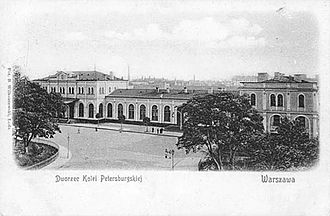Warsaw – Saint Petersburg railway

Warsaw Wileńska Station (1862–1915)
|
|
| Track gauge | (Warsaw–Grodno) 1,435 mm (4 ft 8 1⁄2 in) (Saint Petersburg–Hrodna) 1,520 mm (4 ft 11 27⁄32 in) |
|---|---|
The Saint Petersburg–Warsaw Railway, Russian "Санкт-Петербурго-Варшавская железная дорога" (transcription: Sankt-Peterburgo–Varshavskaya zheleznaya doroga) is a 1,333 km (828 mi) long railway, built in the 19th century by the Russian Empire to connect Russia with Central Europe. At the time the entire railway was within Russia, as Warsaw was under a Russian partition of Poland. Due to territorial changes, the line now lies within five countries and crosses the eastern border of the European Union three times. Therefore, no passenger trains follow the entire route. Travel by passenger train between Saint Petersburg and Warsaw today (2010) passes Brest instead.
In February 1851 the Tsarist Government of Russia made a decision to build the St. Petersburg–Warsaw railway line with a length of approximately 1,250 kilometres. It was built to Russian gauge. Construction was completed in 1862.
The first section of the railway was completed in 1853 between Saint Petersburg and Gatchina, with daily scheduled train service started on October 31, 1853. On July 19, 1858, the first train arrived in Pskov.
In May 1858, construction started near Vilnius on the first section of 19 kilometers. On 1 May 1859 the ground works started along the entire route Daugavpils–Vilnius–Lentvaris–Kaunas–Kybartai. The end of summer of 1860 marked the end of the construction of the Ostrov-Daugavpils–Vilnius railway. The first train from Daugavpils arrived in Vilnius on 16 September 1860. In 1861, this branch was completed to the Prussian border, and between Verzhbolovo Station in Kybartai and Eydtkuhnen in Prussia (now Chernyshevskoye in Russian Kaliningrad Oblast) the first junction between Russian gauge and standard gauge railway systems was built, with rails in both gauges between the border stations.
...
Wikipedia
